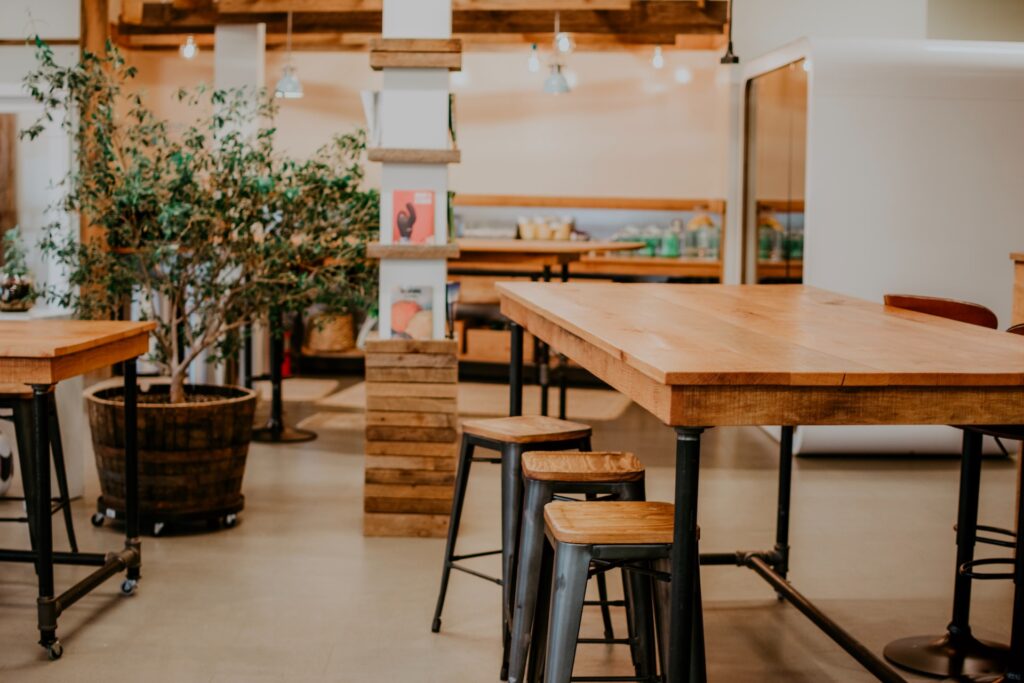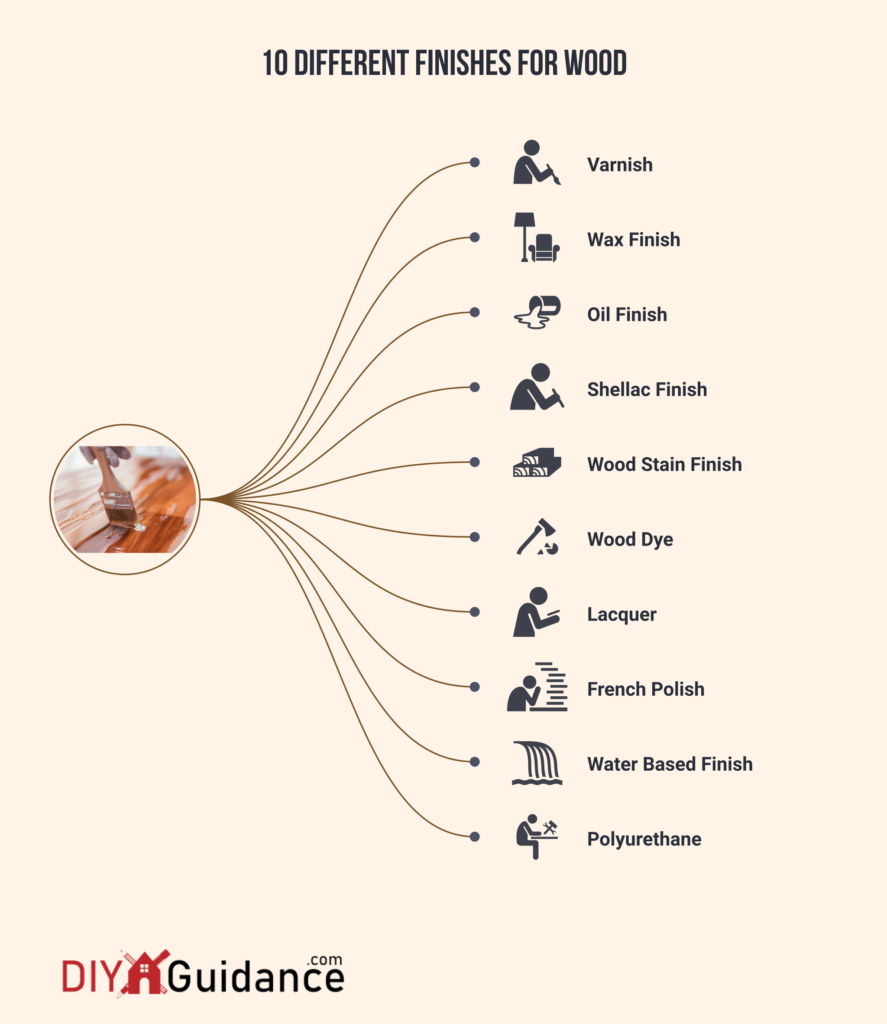Do you want to choose from different finishes for wood available? Perhaps, you’re looking to create the perfect aesthetic in your home. The type of finish you choose for your wood will determine the overall look and feel of its appearance.
Whether it be furniture, kitchen cabinets, or doors. Understanding the types of finishes and what they can do for furniture will give you a professional-looking and durable piece.
This article will provide insight into the many different finishes for wood. In order to help you select the right finish choice.
Is Finishing Wood Necessary?

When it comes to wood furniture and flooring, there is a lot of debate about whether or not you should finish the wood. On one hand, unfinished wood can look rustic and cozy. On the other hand, finished wood can provide your home with a timeless look that will last for years to come. To help you decide if finishing your wood is the right choice for you, here are five benefits of finishing your wood furniture and floors.
❋Protection from Moisture Damage
One of the most important benefits of finishing your wood furniture and floors is protection from moisture damage. Unfinished wood is much more susceptible to cracking, warping, and discoloration due to changes in humidity levels in the air. Finishing your wood will create a protective barrier against these potential moisture issues.
❋Easy Cleaning
Finished wood is much easier to clean than unfinished wood because dirt won’t get stuck in between the grooves of the boards as easily. This means that it won’t take as much time or effort to keep your furniture looking its best.
In addition, finished surfaces resist stains better than unfinished surfaces, meaning that they are less likely to be affected by spills or accidental messes.
❋Increased Durability
Finishing your wood adds an extra layer of protection which can help extend its life significantly. A good finish will help protect against fading from UV rays and also reduce wear and tear from everyday use. This means that it can withstand heavier use without showing signs of wear like scratches or dents over time.
❋Aesthetic Appeal
A properly finished piece of furniture looks much nicer than an unfinished one because its natural beauty is enhanced by a glossy sheen or matte finish that helps bring out the grain patterns in the wood.
Plus, when it comes time to sell your home down the road, buyers are more likely to gravitate towards homes with finished hardwood floors than those with unfinished ones since they give off a more polished look overall.
❋Cost Savings
It may seem like an expensive endeavor upfront but over time it can save you money in the long run. Due to increased durability and decreased maintenance costs associated with keeping them looking their best year after year.
Now that you are aware of the many benefits of finishing your wood furniture and floors, let’s take a look at some of the different types of finishes available.
The Different Finishes for Wood

There are several types of finishes you can use on your wood furniture or flooring. Here are some of the most popular finishes and their benefits.
👉Varnish
Varnish is a hard-drying oil-based product that is often used as a topcoat on wood surfaces. It provides excellent protection from moisture, heat, and dirt while adding a glossy sheen to the wood’s surface. Varnish is renowned for its enduring nature, making it unlikely to chip or flake away as if often seen with other finishes. To ensure that varnish retains its shine and luster, regular upkeep such as sanding and reapplication must be made every several years.
👉Wax Finish
Wax finishes are well-known in woodworking for bringing out the natural beauty and color of the wood. Whether it’s a hard paste wax, spirit polish, or a brushable liquid wax, these applied finishes bring out the grain of open-pored woods and seal the surface against dust and dirt.
This approach to finishing is often used with furniture because it will not yellow or darken with age. As an added benefit, regular cleaning and reapplication can maintain a satin sheen on any piece of furniture. Wax finishes are also relatively inexpensive when compared to many other types of finishes available for woodworking projects.
👉Oil Finish
Oil finishes are one of the timeless, classic finishes for wood due to their natural look and ability to enhance the character of the grain. The oil, usually derived from a plant, sinks into the pores of the wood and not only protects it from scratches and dirt but also nourishes it with special substances.
The finish is fairly low maintenance as it doesn’t require scraping or sanding to reapply; all you need is often just light dusting or cleaning. Keep in mind that some oils can darken with time and show water marks easily, so furniture that comes in contact with moisture should be avoided when using an oil finish. Here are the types of oil finishes:
- Linseed oil: It is one of the oldest forms of wood protection and is derived from flax plants. It penetrates smoothly but can become sticky when used in large quantities and builds up quickly.
- Mineral oil: It is almost odorless and tasteless and dries to a hard, water-resistant surface. While it doesn’t penetrate as deep as linseed oil, it helps keep moisture out better.
- Tung oil: It is extracted from the nuts of the tung tree and creates a hard film that resists water if applied correctly – great for indoor furniture.
- Walnut oil: It preserves wood but will darken considerably once applied, so this choice works best with darker woods that may not be affected in color by its application. For softer woods such as maple or cherry.
- Danish Oil: It’s a combination of linseed and mineral oils that might work best since it has less tendency to yellow or darken over time than other varieties like teak oil which usually requires ongoing maintenance.
👉Shellac Finish
Shellac is a popular finish for wood due to its glossy appearance and ease of application. It comes in both liquid and spray form, so it can be used with a brush or a spray gun. Unlike some other finishes, this one dries quickly and gives an extremely hard-wearing surface that’s resistant to scratches and water.
Shellac is often used on furniture and antiques. It also protects acids which can cause discoloration or yellowing over time. It is ideal for pieces that will have heavy use or require cleaning regularly.
👉Wood Stain Finish
Wood stain finish is a popular choice for many people looking to enhance the beauty and character of their woodwork. Staining is a great way to bring out the texture and grain of the wood, producing a unique look that can range from light and natural to intense.
The type of stain you choose will greatly influence the appearance it creates. Oil-based stains offer more vibrant colors but are also more difficult to remove if you want to change them in the future. Water-based stains are much easier to use; they dry quickly and can produce excellent results with less mess. You should always test stains on scrap wood before applying them to your finished project to get an accurate idea of how they will look in the end.
👉Wood Dye
These medium-grade dyes are used most often in furniture restoration due to their ability to be wiped off with steel wool. Dyeing is great for being able to create pops of color that won’t obscure the natural grain of the wood yet will certainly stand out as lovely accent pieces in any décor.
However, users should remember that wood dye is water resistant but not waterproof so care should be taken when placing items finished with this product near high-humidity areas such as kitchens and bathrooms.
👉Lacquer
With its high-gloss and modern look, lacquer gives the wood a beautiful sheen that won’t chip or fade over time. For a traditional glossy finish, nitrocellulose lacquer is often used due to its durable and resilient characteristics. This type of lacquer also brings out the natural beauty of the wood grain, making it a popular choice for cabinets, paneling, furniture, and more. For those who prefer a less reflective sheen, there are both acrylic lacquer and conversion varnish which can vary in their levels of glossiness.
👉French Polish
It’s an age-old technique where shellac is applied in thin colorful layers to create a beautiful finish on wood furniture pieces and other items. The technique involves much time and patience so it’s an option for those looking for something long-lasting and of the highest quality.
French polished wood tends to have a deep richness about it that makes any piece slide into a room like butter as though it’s always been there. The hand-crafted process gives each item a character of its own and results can be quite stunning when done correctly.
👉Water Based Finish
From a clear matte gloss to a glossy shine, water-based finishes can be used in various ways. This type of finish is great for staining projects because it’s fast drying, durable, and easy to use. Not only does it protect your work from wearings and tearings, but it also gives the wood a pleasant appearance.
It can highlight the natural grains and colors of the wood while giving off an ultra-smooth texture. Water-based finishes are suitable for both interior and exterior projects. Making them one of the most versatile options when choosing what type of finish is best for your wooden furniture or surface.
👉Polyurethane
Polyurethane provides a glossy, protective layer that is durable and impact resistant. This finish is available in various formulas and depths, ranging from a light sheen to a glossy finish. It has excellent water resistance so it can be used for any woodworking project both inside and outside of the home.
Its non-toxic formula makes it ideal for furniture items that may come in contact with food or skin. Additionally, polyurethane doesn’t require too much maintenance; periodic polishing can help to maintain its shine and condition.
These are just a few of the many types of wood finishes available on the market today. Each type has its benefits and drawbacks, so it’s important to consider your project before deciding which one is best for you.
Wood Finishes Buying Considerations

Aside from the different finishes for wood, there are some common considerations to keep in mind when deciding which type of finish to choose.
✔️Sheen Level
Once you’ve chosen a type of finish, the next step is to select the sheen level that best suits your needs. The most common sheens for wood finishes are satin (low luster), semi-gloss (medium luster), and gloss (high luster).
The higher the sheen level, the more durable and easier to clean the finish will be. However, high gloss finishes can also appear too shiny if applied in large areas or on dark woods.
✔️Color Matching Ability
Depending on what type of wood you’re working with. It may be important to select a wood finish that can match its color accurately and consistently when reapplied over time.
If this is something you need in your project, make sure to look for a product that specifies “colorfastness” as one of its features. Or choose an option that offers tinted versions so you can mix in custom colors or shades as needed.
✔️UV Protection
If your project requires outdoor use or extended exposure to sunlight, make sure that your chosen product provides UV protection. Sunlight can cause fading or discoloration over time. So choose a product that has added UV blockers for long-term protection.
✔️VOC Content
Volatile organic compounds ( VOCs ) are chemicals that evaporate into the air at room temperature. Some products contain high levels of VOCs which can produce strong odors and may even be harmful if inhaled.
Look for products with low -VOC content or ones specifically labeled “no -VOC ” if this is important to you.
✔️Application Process
Different types of wood finishes require different application methods. So make sure that you purchase a product suitable for the job at hand. For instance, some water-based products must be sprayed onto surfaces while others must be wiped on by hand. Meanwhile, oil-based products require brush application only.
✔️Coverage Area
Depending on the size of your project area, you may need more or less coverage than what comes in one canister of wood finish. Be sure to check the coverage area listed on each product label before making your purchase so that you don’t end up with a surplus (or shortage) of product at the end of your project.
✔️Drying Time / Cure Time
It’s important to factor in drying/cure time when selecting a product because some formulas may dry faster than others based on their ingredients and application process used during manufacturing.
While some products may reach full cure within hours, others may take days before they reach maximum hardness and durability. So keep this in mind when making your selection.
✔️Cost per Gallon / Ounce
Wood finishing products come in various sizes ranging from small 4 oz tins up to gallons. And prices will vary depending on the amount purchased as well as brand name recognition.
If you plan to use the same product for multiple projects or on a regular basis, it can be worth splurging on a larger size to save money over time.
Make sure you shop around and compare prices between different brands and retailers. Oftentimes they’ll have sales going on where prices are drastically reduced from their regular rates. This can help save money in the long run if done properly.
✔️Clear vs Tinted Option
As mentioned previously. Some brands offer both clear versions as well as tinted versions colored with pigments or dyes that allow users to mix custom color matches.
If this is something you’re interested in, make sure to select the right product, and keep in mind that tinted versions may not be as durable or UV resistant as their clear counterparts.
✔️Brand Name Recognition
It doesn’t hurt to read reviews online about different brands before making your selection. As some manufacturers have better reputations than others when it comes to providing consistent quality across all their products.
Take the time to read up on what other customers have experienced with certain brands and products to get a better idea of what you can expect from your purchase. This can help ensure that your project turns out as expected.
These are all important considerations when selecting the right wood finish for your project.
Frequently Asked Questions
What is the best finishing for wood?
Polyurethane is unquestionably the best finishing for wood; offering a glossy and protective coating that will last far longer than other sealants, including wax. This finish doesn’t yellow over time, instead increasing in clarity and beauty as it ages.
Furthermore, polyurethane is incredibly easy to apply yourself; all you need is a clean surface, a quality applicator and brush, and the right materials. It’s inexpensive too. One of its greatest qualities lies in the fact that it’s highly durable and scratch-resistant. Perfect for doors or surfaces that will receive high levels of traffic.
What is the safest wood finish?
Shellac is an excellent choice due to its nontoxic characteristics, making it a great choice for anyone who wants to avoid chemical-based solutions. Waxes and oils are also safe options. Although they may not offer as much protection as urethane or polyurethane. Which can help maintain the appeal of your furniture without potentially hazardous chemicals.
There is no single perfect finish; however, doing research into the various options before you make a decision is essential. In order to ensure that it will provide the best combination of safety and protection without forsaking aesthetics.
How do you finish wood so it looks natural?
Oils penetrate deep into the wood, resulting in a natural sheen that can last for years without the need for reapplication. Varnish, on the other hand, provides a protective barrier over the top of the wood. While allowing it to remain visible and retain some of its natural look and color. Whichever you choose to use, taking care when preparing the surface and applying coats will help ensure good results.
What is the best finish For Soft Wood?
Softwoods such as pine or cedar are best finished with an oil-based stain or sealer. These products will penetrate the wood, helping to protect it from water damage and other environmental factors.
They will also bring out the natural beauty of these types of woods without making them overly glossy as some other finishes might do.
What is considered high-end finishes In a home?
High-end finishes for your home may include things like hardwood flooring, marble countertops, or custom cabinetry made from exotic hardwoods such as mahogany or teak.
Depending on your budget, there are many high-end finishes available that can give your home an elegant and luxurious feel without breaking the bank.
Final Words
The different finishes for wood mentioned in this guide are all excellent and have their benefits. Ultimately, it comes down to the surface you’re looking to finish off, as well as the look and effect that you want to obtain.
Choose a finish that best suits your project, and make sure to do your research to get the best results. With a little bit of effort and knowledge, you can have beautiful wood projects that will last for years.


